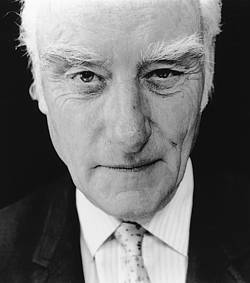The Secret of Life

Physicist and molecular biologist Francis Crick, co-discoverer of the double helix structure of DNA with James Dewey Watson (1953) and co-winner of the 1962 Nobel Prize for Physiology or Medicine, was born on this day in 1916 near Northampton, England.
The son of a shoe salesman, Francis Crick studied physics at University College London, and during World War II designed non-contact "magnetic" mines for the British navy. After the war, influenced by his own long-held atheism and by Schrodinger's What is Life?, Crick decided to immerse himself in the "living-nonliving borderline" of biology to study the basis of life, taking up the call of Linus Pauling, who just after the war had boasted about the prospective role of structural chemistry in understanding the biological microworld.
Crick went to Cambridge and eventually joined Max Perutz's X-ray crystallography lab which was then investigating the structure of proteins. Although it was thought that the genetic material in a cell was a protein and that a polymer, deoxyribonucleic acid (DNA), might be a factor in the manufacture of proteins, little insight had been gained into why this polymer was particularly suited to replication.
Meanwhile, in 1951, young Jim Watson, an American biochemist, arrived at Perutz's lab, and the two became fast friends and office-mates; apart from both having read Schrodinger, they shared a ruthless, somewhat arrogant sense of the same mission -- figuring out the relationship between the structure of DNA and its function in molecular genetics. Relying upon the experimental work of others (including the X-ray photographs of DNA taken by Rosalind Franklin in Maurice Wilkins' lab at University College London), Crick and Watson began to build models of the DNA molecule out of cardboard, wire and beads. On February 21, 1953, Watson noticed the complementary shape of adrene-thymine and guanine-cytosine, the base pairs of proteins underlying DNA, and together Crick and Watson worked out a picture of DNA as a ladder-like double helix, founded upon what was known through experiments, showing two chains of molecules linked by hydrogen bonds.
Watson says Crick went to the Eagle Pub at the end of the day and announced at the top of his lungs that he had discovered the secret of life; Crick's wife said he was always saying things like that, so she didn't pay him any particular attention. Crick and Watson published a short paper on their hypothesis in Nature (Apr. 1953), and in it noted, "It has not escaped our notice that the specific pairing we have postulated immediately suggests a possible copying mechanism for the genetic material."
Watson left Cambridge shortly thereafter, but Crick stayed on at Cambridge to become a dominant force in molecular biology, predicting the discovery of transfer-RNA as a mechanism for the manufacture of proteins within a cell and postulating the "central dogma" in molecular genetics (since unraveled by the behavior of certain viruses, but still largely revered as a key principle), that genetic information could only pass one way -- from protein to RNA to DNA. In 1976, Crick moved to the Salk Institute for Biological Studies in La Jolla, California to study consciousness and the brain. In The Astonishing Hypothesis (1994), his materialist habits of mind revealed themselves again as he theorized an electrophysical basis of human consciousness. He died July 29, 2004 in San Diego, California.
Labels: Biologists and Physiologists, Physicists





0 Comments:
Post a Comment
Subscribe to Post Comments [Atom]
<< Home